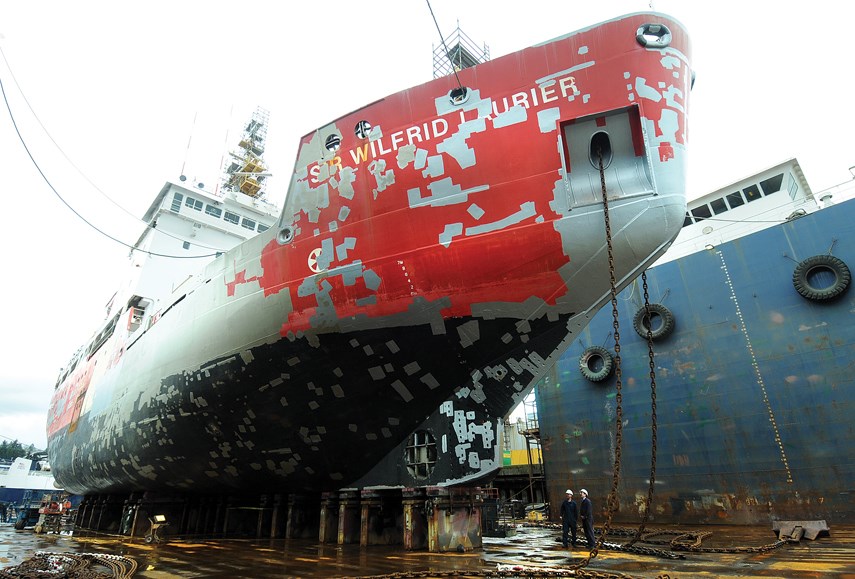Sitting on keel blocks in Vancouver Drydock’s 30,000-tonne lift, the towering hull of the Canadian Coast Guard Ship Sir Wilfrid Laurier looms against the North Vancouver skyline.
It’s about 36 metres from the bottom of the hull to the tip of the mast.
The ship’s smart red and white colours have been temporarily replaced with a mottled, pixelated appearance – loose paint on the hull has been spot-blasted off, then recoated with primer before a final coat of epoxy paint goes on.
There’s a newly welded scar on one side of the hull where a two- by three-metre hole was cut to take out the old auxiliary generator and put a new one in.
The rounded icebreaking bow at the front of the ship rises above an angled “ice knife” in a shape designed to reduce friction and push the ice slabs under the vessel.
With a displacement of more than 5,000 tons and a length of 83 metres, the Wilfrid Laurier is the largest ship in the Coast Guard’s West Coast fleet.
And when it comes to icebreakers, size matters.
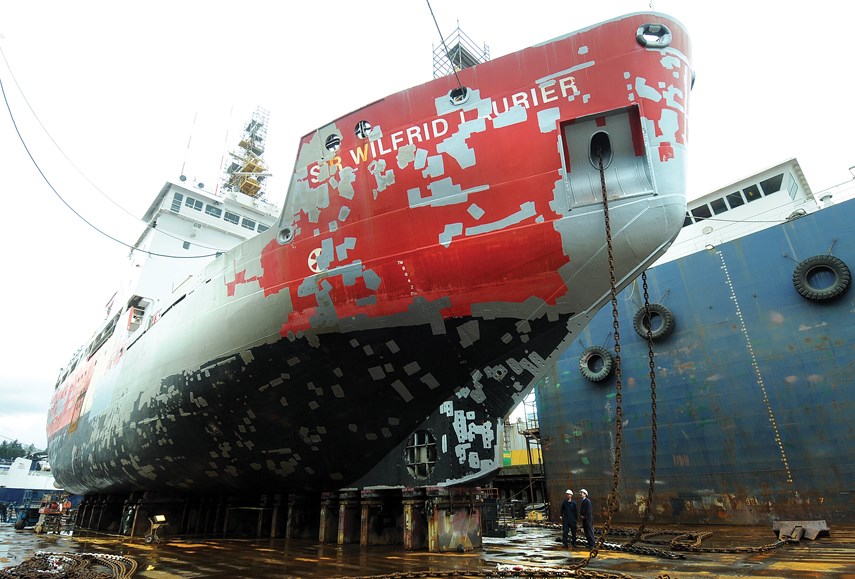
Powered by three massive diesel electric engines capable of creating about 9,000 horsepower, the ship’s generators power motors which turn two huge propellers made of a nickel-aluminum-bronze alloy.
“A lot of Coast Guard ships have variable pitch (propellers) but for an icebreaker you want fixed pitch,” says Randy Morford, the ship’s chief engineer. The fewer things that are moving in the ice, the fewer that can go wrong.
Steel for the hull is more than an inch thick in places.
The Wilfrid Laurier isn’t as big as some of the Coast Guard’s heavy icebreakers, but does well in the western Arctic, where water is shallow.
In some places, “You can’t get close to shore, even in a small boat,” says Capt. Bill Noon, who grew up in West Vancouver and has been captain on the Laurier since 2009, making his first trip into the Arctic as chief officer on the vessel in 1994.
First-year ice is “fairly soft,” says Noon. “We have no problem working in that ice.”
The Laurier can power through ice up to one and a quarter metres thick at a speed of three knots.
Older ice that’s frozen and thawed over multiple years is a lot more trouble. “It gets a lot thicker. Hard as concrete,” says Noon.
When the ship is on its regular summer patrol of the western Arctic, an onboard helicopter helps to scout paths through the worst of it.
The ship is fully self-sufficient, and can stay at sea for 120 days at a time.
“We hold about a million litres of fuel,” says Morford.
A desalination and reverse osmosis system onboard can make up to 24,000 litres of water a day.
The ship also has a pretty good machine, welding and pipefitting shop on board, says Morford. When the ship is in the Arctic and something breaks down, “We can’t call someone,” he says. “We have to fix it ourselves.”
A crew of 27 rotates in every six weeks during the summer season, which runs from the beginning of July to October.
While most of the Coast Guard’s icebreakers operate in the eastern Arctic, the Wilfrid Laurier’s territory runs from the Yukon/Alaska border to the Bellot Strait – somewhere 2,500 kilometres north of Winnipeg.
“We’re the only Canadian government ship assigned to that area,” says Simon Dockerill, relief captain on board the ship. “It’s a vast, vast area.”
The average age of the Coast Guard fleet is more than 30 years old.
A large 150-metre heavy icebreaker that will replace the 50-year-old Louis St. Laurent is scheduled to be built at Seaspan Shipyards after the Navy’s joint support ships as part of the federal government’s national shipbuilding program.
But that ship – and smaller ships like it – won’t be ready for a number of years.
In the meantime, maintenance like the work carried out in Vancouver Drydock since the end of February is key to extending the life of the existing ships. Major refit work can add another 10 to 15 years.
Built in a Great Lakes shipyard in 1986, the Sir Wilfrid Laurier is no exception. Around that same time, several other polar icebreakers were built for the Coast Guard in North Vancouver shipyards.
The Amundsen and the Pierre Radisson were both built at Burrard Drydock in 1978 and 1979 while the Martha Black was built at Versatile Shipyard in 1986.
“A (bulk carrier) you’ll see out here in the harbour, you might get 20 years out of it if you’re lucky,” says Dockerill. “Government ships are designed for much longer lives. You can get 40 or 50 years out of them easily.”
The work that makes that possible doesn’t come cheap. A regular refit like this one – done every two or three years – usually costs about $1 million, says Edward Camilleri, senior vessel maintenance manager for the Coast Guard. Special projects this time – including the generator replacement and installation of a specialized multi-beam sounder that can create three dimensional maps of the ocean floor – have pushed the cost to $4.8 million.
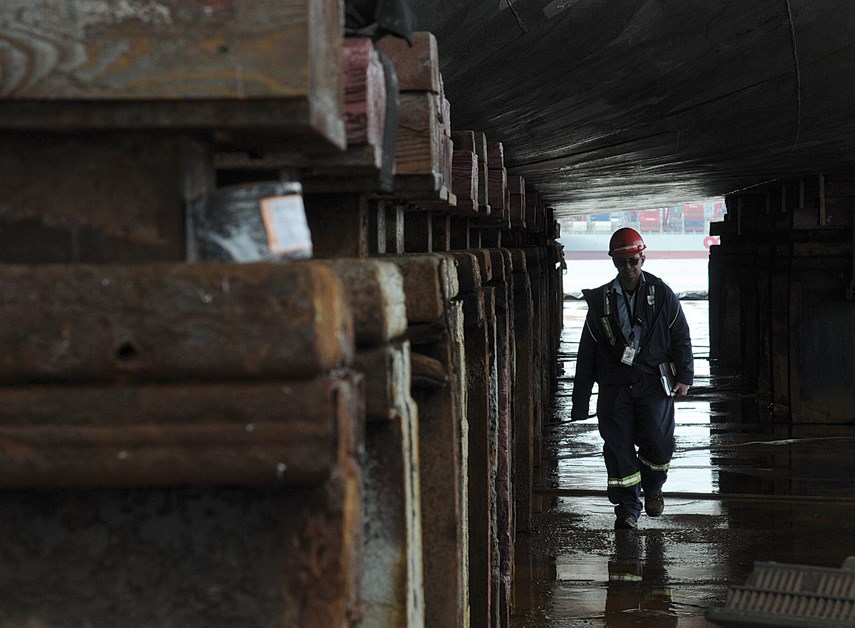
During winter months, one of the Laurier’s tasks is to check and repair navigational and weather buoys along the Pacific coast, including three weather buoys anchored about 500 miles offshore that provide information for West Coast forecasts.
The ship does similar tasks on its Arctic route, where it’s responsible for both buoys and land-based beacons. “Winters are pretty harsh,” says Noon. “Sometimes polar bears will knock down towers.”
The ship also serves as a moving van and supply ship for remaining manned lighthouses along the B.C. coast and provides marine search and rescue.
The Wilfrid Laurier was already working in waters of the central coast on the night of March 22, 2006 when an ominous call came over the radio. The Queen of the North had struck Gil Island and was taking on water. Passengers and crew were preparing to abandon ship.
“I remember it like it was yesterday,” said Morford. “The captain phoned me. He said, ‘We need full power right away. A B.C. ferry is sinking.’”
Engineers cranked up all three engines to top speed, arriving on the scene after the ferry had already slipped beneath the water. When he got out of the engine room and up on to deck, Morford remembers an eerie flat calm hung over the scene of lifeboats and small vessels lit up under emergency flares. “There was debris floating all over,” he said. “It’s one of those things you don’t ever want to see, but when you do see it, it’s burned into your memory.”
In the Arctic, one of the ship’s jobs is to support the economy of the North by ensuring passage for a small armada of barges, tugs and commercial vessels like container ships that provide a lifeline to communities like Taloyoak, Gjoa Haven, Cambridge Bay and Kugluktuk scattered around the western Arctic.
During a six-week summer window, ships bring in everything from food to pickup trucks, televisions to outboard motors and a year’s supply of fuel.
Most goods arrive by ship because air travel is still very expensive.
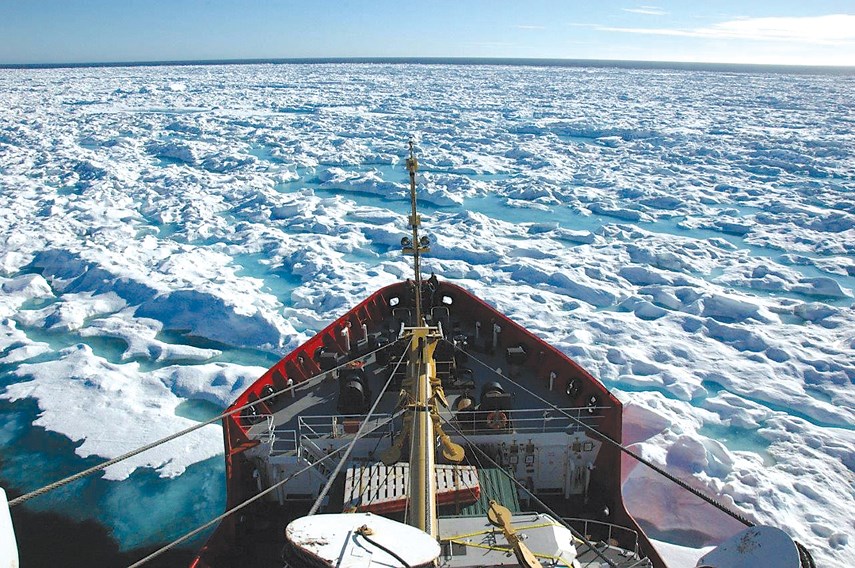
Adventure tourism is another area that’s booming. “Believe it or not there are cruise vessels in the Arctic,” says Morford. “Next year, Disney is going up.”
Many of the ships are “ice strengthened” but often still require an escort. The Canadian government provides that free of charge, as part of its mandate to facilitate trade and promote the economy of the North.
These days it’s not uncommon to see five to eight cruise ships during a summer season, says Noon.
Some adventurers are better prepared than others.
“People have tried to row through and people have taken jet skis through. People have done all kinds of crazy things,” says Dockerill. “That’s generally not recommended. That didn’t end well.”
In February, a federal court judge dismissed a claim against the Canadian government, filed by the Bahamas-based owners of an Arctic cruise ship that ran aground on a rock shelf in August 2010. Instead, the judge fined the ship’s owners about $500,000 for the costs of environmental cleanup. The Wilfrid Laurier was part of the salvage operation for the damaged cruise ship, after passengers were evacuated.
One of the less tangible parts of the job is simply being there. “It’s waving the flag, doing sovereignty patrols,” says Morford. “It’s a Canadian presence.”
During the summer Arctic patrols, teams of scientists and hydrographic crews swell the ranks of those onboard the Wilfrid Laurier to over 50.
Scientists from Sidney’s Institute of Ocean Sciences do ocean water studies up to the Arctic coast every year from an onboard laboratory. The ship has also been deployed in research projects to study ice dynamics in the Beaufort Sea.
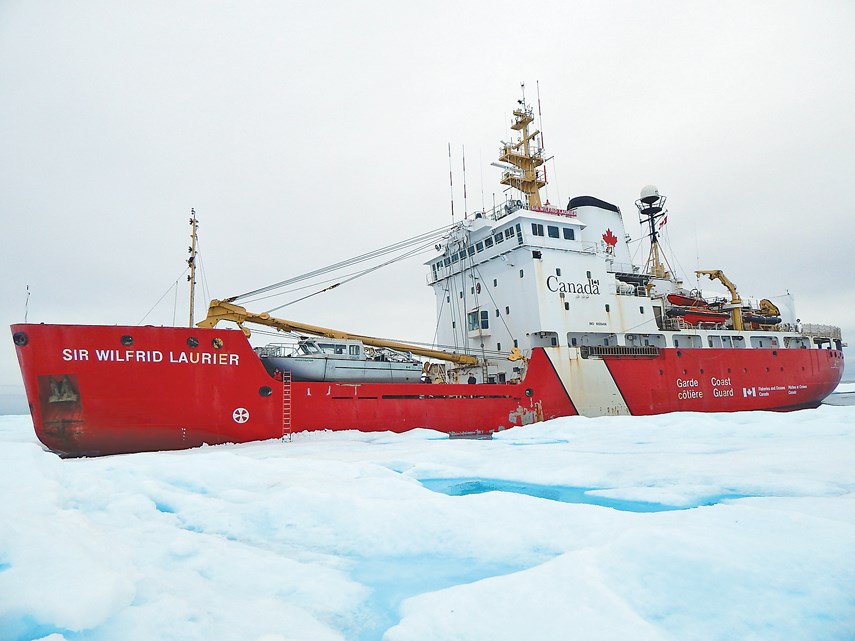
Climate change is visible in the north, says Noon. In 1996, for instance, the changing sea ice was so thick in the Arctic “we had to come back via Halifax and the Panama Canal,” says Noon. “I don’t think that will ever happen again.”
But as one of the few truly uncharted places on the planet, the Arctic still has a pull. Only about 13 per cent of the Canadian Arctic is charted. “We’re still finding dangerous shoals every season,” says Noon.
Working with the Canadian Hydrographic Service to chart the ocean floor is a key task during summer patrols.
That is primarily how the Wilfrid Laurier found itself at the centre of the Parks Canada search for the lost ships of the expedition led by Sir John Franklin – the HMS Erebus and HMS Terror – which disappeared without a trace in 1845 with 129 men on board.
Since they were sounding uncharted waters where the ships might be, researchers suggested looking for the ships at the same time. “Every year the project got bigger and bigger,” says Noon. By the summer of 2014, “It became a giant very busy project that was super intense and active.”
That summer, the plan was to search in a northern area of Victoria Strait off King William Island. But when they got there, “It was completely frozen in. We went south because the ice wouldn’t let us search in the north,” said Noon.
It was there – shortly after a helicopter pilot found an old ship’s davit on a beach – that an archeological crew identified the ship later identified as the Erebus on a sonar image. The find was kept secret for a few days, while a strict protocol was followed detailing who would be informed. Noon recalls being summoned to his own cabin by the team of archeologists and being shown the sonar image of the ship on the ocean floor. As a history buff familiar with the Franklin story, “It was an incredibly emotional moment,” he said.
Later the archeologists secretly brought the ship’s bell on board into the science lab. Noon recalls knocking on the locked door. “They said ‘No, we’re busy.’ I said ‘I’m the ship’s captain.’”
When he saw the bell, Noon recalls it was a beautiful, powerful sight. There was no ship’s name on it. But there was a date: 1845.
One of the big projects underway now on the ship at Vancouver Drydock is installation of a multi-beam sounder on board the Wilfrid Laurier – a specialized instrument that will create three-dimensional maps of the ocean floor. A console will also be installed in the wheelhouse, so officers on the bridge will see the images being sent to the on-board science lab. Under the bottom of the ship, a round valve marks the spot where the sounder will be lowered from a new watertight compartment.
Two small GPS receivers are also being installed on the satellite dome to ensure the location of the images is precise.
Last year, in September 2016, the Sir Wilfrid Laurier was again in the area when another search vessel under the command of a non-profit foundation discovered Franklin’s other vessel, the Terror, in Terror Bay. But there was no time to explore, said Noon, because the weather soon moved in. “Once winter hits you have to get out of there,” he says.
Part of the allure of the Arctic has always been its mystery, says Noon.
The area where Franklin’s ships were found was still a white space on the charts, he says. “The charts haven’t really improved since he came though.”
“Partially you feel like you’re still exploring a bit,” he says of the annual trips to the Arctic on board the icebreaker. “It feels like you’re carrying on a historical legacy.”
The Sir Wilfrid Laurier is expected to go back in the water this week, departing North Vancouver by the end of April.
